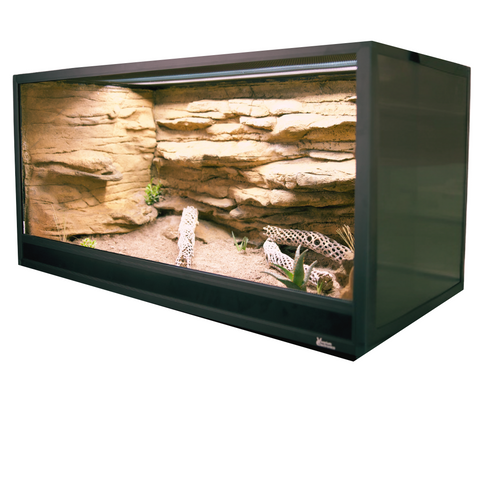Natural History
Green tree monitors are a strikingly arboreal species of monitor lizard native to the tropical rainforests of New Guinea and nearby islands. They exhibit a highly specialized lifestyle built around life in the treetops of dense, humid forest canopies. Understanding their biology, natural behavior, and ecological role is crucial for any keeper aiming to replicate appropriate care in captivity.
From hatchling to adult, the green tree monitor undergoes several distinctive life stages. At birth, hatchlings typically measure around 8 to 10 inches in total length, with a large proportion of that length made up by their tail, which can be prehensile even at this young stage. Reaching maturity takes about 2 to 3 years, during which time they grow rapidly under optimal conditions, eventually averaging 24 to 36 inches in total length as adults. Females are typically smaller and more slender than males. Mating can occur throughout much of the year in the wild, particularly after heavy rains or changes in atmospheric pressure, which may signal the start of a favorable wet season. Females usually produce clutches of 2 to 5 eggs, often deposited in arboreal termite mounds high above the forest floor. The incubation period is typically around 150 to 190 days in nature, depending on environmental variables such as humidity and temperature. Parental care is absent after oviposition, a common trait among monitor lizards, and hatchlings are independent from the moment they emerge.
Behaviorally, green tree monitors are intelligent, alert, and highly active lizards. They are predominantly diurnal, meaning they are active during daytime hours, and they spend most of their time climbing, hunting, and basking in the treetops. Unlike many other monitor species, green tree monitors are particularly well adapted to three-dimensional movement, using their long toes, recurved claws, and prehensile tails to move fluidly through branches and foliage. They are opportunistic insectivores in the wild but will also take small vertebrates and eggs when available. Their hunting strategy involves quick bursts of speed combined with stealth; they use exceptional visual acuity to locate prey before striking with precision. Green tree monitors are generally solitary animals, although occasional tolerance of conspecifics may occur in overlapping territories or in resource-rich areas. They are known to be territorial, often defending favored basking or nesting sites with postural displays, tail lashings, or bites if threatened.
In terms of predator avoidance, green tree monitors rely on a combination of cryptic coloration and speed. Their vivid green coloration provides excellent camouflage among the leaves of the canopy. When threatened, they often flee swiftly into a dense tangle of branches or use their powerful tails as defensive weapons. Juveniles are especially vulnerable and exhibit extremely cautious behavior, remaining motionless or hidden for long periods.
Ecologically, green tree monitors play a vital role in the ecosystems of New Guinea’s lowland rainforests. As mid-level predators, they help control populations of insects, particularly orthopterans and beetles, as well as small vertebrates such as frogs, lizards, and rodents. Their predation helps regulate prey populations, thereby maintaining ecological balance. They are, in turn, preyed upon by larger snakes, birds of prey, and carnivorous mammals. Hatchlings and juveniles are especially susceptible to predation, which shapes their cautious behavior and secretive habits during early life stages. By nesting in arboreal termite mounds, green tree monitors exhibit a remarkable adaptation to avoid terrestrial egg predators and maintain stable incubation conditions. This behavioral link with termites is a unique ecological interaction within their habitat. Their dependence on intact canopy structures makes them sensitive bioindicators of rainforest health; declines in green tree monitor populations may signal broader ecosystem disruptions such as deforestation or climate change.
Understanding the green tree monitor’s complex behaviors and ecological dependencies is essential for providing proper captive care. Their natural history reflects a life built high in the rainforest canopy, combining agility, intelligence, and ecological specialization—traits that must be acknowledged and respected in any captive environment.
Conservation Status
The Green Tree Monitor is currently classified as "Least Concern" on the International Union for Conservation of Nature (IUCN) Red List. This status indicates that the species does not currently face an immediate risk of extinction across its range. Populations are considered stable in several areas, and the species occupies a relatively wide geographic distribution across parts of New Guinea and surrounding offshore islands. However, while the classification of Least Concern suggests healthy population numbers and a degree of ecological resilience, it does not imply immunity to environmental or anthropogenic pressures. In fact, some local populations may be declining or at risk due to emerging threats, and ongoing monitoring is essential to ensure the overall long-term health of the species throughout its native range.
The primary threats to wild populations of the Green Tree Monitor include habitat destruction, particularly due to deforestation for logging, agriculture, and infrastructure development. Because this species relies heavily on dense, lowland tropical rainforests in which vertical structures, such as tree trunks and canopies, provide essential habitat for foraging and nesting, any disturbance or fragmentation of these habitats can severely impact their ability to survive and reproduce. Climate change may also pose a long-term threat by altering precipitation patterns and temperature regimes, further impacting rainforest structure and prey availability.
Illegal collection for the international pet trade presents an additional pressure on wild populations. Despite international regulations, illicit capture and export continue in some areas. Juveniles and brightly colored adults are especially vulnerable to overharvesting due to their desirability in the exotic pet market. While their elusive nature and arboreal lifestyle offer some protection, repeated harvesting in localized regions can cause significant population declines and disrupt natural breeding structures. Additionally, limited studies suggest that invasive predators, such as feral cats, may pose threats to eggs and juveniles, compounding other stressors in disturbed habitats.
Conservation efforts aimed at protecting the Green Tree Monitor emphasize habitat preservation and legal protections. Several protected areas within their native range have helped to maintain essential forest cover, thereby safeguarding key populations. These include national parks and conservation reserves where commercial logging and agricultural expansion are restricted. Furthermore, international regulations under the Convention on International Trade in Endangered Species of Wild Fauna and Flora (CITES) place limitations on the trade of this species, ensuring permits are required for export and that capture levels remain within sustainable limits. Enforcing these regulations is critical to curbing illegal trade and preventing overexploitation.
Captive breeding programs have also become increasingly important in conservation strategies for this species. Several zoos and private conservation institutions have achieved successful captive reproduction, which provides not only a backup population in the event of wild declines but also helps to reduce demand for wild-caught individuals in the pet trade. These programs also facilitate research into the species’ behavior, reproductive biology, and husbandry needs, all of which contribute to improved care in captivity and informed conservation approaches. While reintroduction into the wild has not been broadly implemented for this species, maintaining a genetically diverse captive population remains a key conservation priority.
By understanding both the current conservation status and the complex challenges faced by the Green Tree Monitor in the wild, reptile keepers and conservationists alike can contribute to the long-term protection of this remarkable and ecologically valuable reptile.
Native Range
The green tree monitor is native to a relatively restricted range in northern Australia and the island region of New Guinea, primarily occupying areas in the northern portion of Papua New Guinea and adjacent Indonesian provinces such as West Papua. The species is also found on a number of smaller surrounding islands in the Torres Strait and nearby coastal archipelagos. Its geographic distribution, while not especially broad, includes a variety of forested zones within tropical climates, typically close to the equator. This distribution coincides with dense, humid rainforest ecosystems that remain relatively undisturbed and provide the arboreal niche suited to this species’ specialized behavior.
The macrohabitat of the green tree monitor consists primarily of lowland tropical rainforests, including primary and secondary forests with thick canopy coverage and high biodiversity. These forests are categorized by consistently warm temperatures, high annual rainfall, and strong vertical complexity, which offer abundant arboreal opportunities for a species that is highly adapted to life in the trees. In certain regions, the species is also occasionally found in swamp forests, mangrove edges, and transitional forest zones, though always in areas with rich foliage and climbing structures.
Within this broader habitat, the green tree monitor demonstrates a strong preference for specific microhabitats. It frequently resides in the mid to upper canopy layer, but may also be found on lower tree trunks or among dense shrubs, especially those that offer hollow branches, intertwined lianas, or thick foliage cover for protection. It is known to utilize arboreal termite mounds and cavities in tree bark as refuges and nesting sites. The species is rarely observed on the forest floor, underscoring its reliance on vertical habitat features and emphasizing the importance of complex three-dimensional environments.
This reptile thrives in climates with daytime temperatures consistently ranging between 82°F and 95°F, with nighttime lows rarely dipping below 75°F. Relative humidity is typically high year-round, often remaining over 80%, although there may be slight seasonal reductions in some regions during brief drier months. Annual rainfall in its range can exceed 100 inches, contributing to the moist substrate and leaf litter that indirectly benefit the species by supporting prey populations and maintaining high humidity. Seasonal changes are minimal in equatorial lowland forests, but slight shifts in wet and dry periods can influence its activity level and reproductive timing.
The green tree monitor is primarily found at low elevations, ranging from sea level up to about 3,200 feet. Most populations are concentrated below 1,500 feet, where precipitation and temperature values align most closely with the species’ physiological and ecological requirements. At higher elevations, the decline in temperature and suitable vegetation architecture tends to limit the species’ occurrence.
Key environmental features essential to the survival of the green tree monitor include continuous access to high humidity levels, dense canopy foliage for shelter and thermoregulation, and a stable population of invertebrate and small vertebrate prey. Arboreal connectivity, such as overlapping tree branches and lianas, is critical for its locomotion and foraging behavior. The availability of rotting logs or tree cavities is important for nesting females, as eggs are deposited in soft decaying wood or termite nests rather than in the ground. Additionally, structural features like vertical tree trunks with rough bark and multilayered canopy provide essential basking sites and retreat cover from potential predators. The species is highly reliant on undisturbed forest conditions, making habitat integrity crucial for long-term population sustainability.
Behavior
The green tree monitor is an arboreal, diurnal lizard native to the tropical lowland and mid-montane forests of New Guinea and nearby islands. In its natural environment, it is active during daylight hours, emerging with the morning light to begin thermoregulating and foraging through the canopy. Its activity peaks in the warmer parts of the day, usually between mid-morning and early afternoon. Seasonal changes can influence its activity levels; while the equatorial climate provides relatively stable temperatures year-round, local fluctuations in humidity and rainfall—particularly during monsoon seasons—can alter its foraging behavior and reproductive timing. In captivity, green tree monitors retain their diurnal patterns but may respond more directly to artificial light cycles, with activity typically beginning shortly after their UVB and basking lights are activated.
Socially, the green tree monitor is primarily solitary, a trait consistent with most varanid lizards. In the wild, interactions between individuals are infrequent and often limited to mating encounters or territorial disputes. Males can be territorial, especially during the breeding season, and may engage in displays of dominance that include body inflation, tail thrashing, and open-mouth posturing. In some cases, combat between rival males has been observed. Females do not exhibit parental care; after laying eggs in arboreal termite nests or other insulated cavities, they abandon the site. Hatchlings are precocial and completely self-sufficient from birth.
The green tree monitor is acutely responsive to environmental stimuli. It uses its well-developed Jacobson’s organ to detect chemical cues from prey, predators, and potential mates, flicking its long, prehensile tongue to sample particles in the air. Visual acuity is also highly developed; it relies on sharp eyesight to identify movement and color differentiation, which aids in hunting and predator evasion. This species reacts strongly to temperature and humidity shifts. In the wild, it employs behavioral thermoregulation by basking in sunlight at canopy level or retreating into shaded leaf clusters to avoid overheating. During periods of high rainfall and decreased temperatures, overall activity tends to drop. In captivity, improper humidity or temperature levels often result in lethargy, skin shedding issues, or respiratory stress, emphasizing the need for precise environmental control.
This species demonstrates several unique behavioral adaptations that set it apart from other monitors. One of the most notable is its exceptional agility and prehensile tail, which it uses for balance and anchoring as it navigates vertically through dense canopy. Its movement is deliberate and serpentine, helping it blend with wind-swayed vines and branches. When threatened, it rarely resorts to aggression—its primary defenses include camouflage and rapid flight into the nearest cover. If cornered, it may lash with its tail or deliver a quick bite. Unlike larger monitor species, green tree monitors are relatively shy and rely more on avoidance than confrontation. Their hunting technique is distinguished by a methodical approach involving stalking, precision striking, and the use of sharp claws to extract insects from bark crevices.
Comparing behavior in captivity versus the wild reveals several differences. In controlled environments, green tree monitors often adapt to stable feeding schedules and artificial light cycles, which can alter natural foraging rhythms. While they are opportunistic feeders in the wild, constantly moving in search of prey, captive specimens may become sedentary without proper environmental enrichment. Boredom and stress can lead to pacing, glass-surfing, or excessive basking, which are behaviors rarely observed in their natural setting. Aggression is also more commonly reported in captive males housed together, especially in enclosures lacking sufficient vertical space and visual barriers. However, with consistent handling and slow habituation, individuals tend to respond well to human presence and can even display a moderate degree of inquisitiveness, especially when offered novel stimuli or food. Despite their solitary nature in the wild, well-adjusted individuals in captivity may develop a level of behavioral tolerance toward keepers, although this should not be mistaken for sociality.
Captivity Requirements
Enclosure Design
Green Tree Monitors are arboreal, semi-tropical lizards that require vertical space more than ground area to thrive. For juveniles, a minimum enclosure size of 3 feet tall by 3 feet wide by 1.5 feet deep is acceptable. However, this is only suitable for the short term. As adults, Green Tree Monitors require a significantly larger and vertically-oriented habitat. The minimum enclosure for an adult should measure at least 4 feet tall, 4 feet wide, and 2 feet deep. For optimal welfare and natural behavior expression, larger enclosures are strongly encouraged whenever feasible.
Since this species is highly active and utilizes vertical space extensively, the enclosure should be designed with multiple levels and an abundance of climbing structures that simulate their natural forest canopy habitat. Use natural hardwood branches of varying diameter, cork rounds, and securely mounted platforms to encourage climbing and basking. Artificial vines and foliage may be added to increase coverage and reduce visual stress. At least two secure hides should be placed at different elevations—one cooler, one warmer—offering refuge and controlling stress. Horizontal basking shelves near the top of the enclosure are essential. Ventilation must be excellent to prevent stagnant air and excess moisture while maintaining adequate heat retention. Screen panels placed strategically for cross-ventilation and solid sides made from PVC or ABS plastic provide a balance of ventilation and insulation. Avoid glass enclosures unless equipped with high ventilation to prevent humidity-related complications.
Ensure that the enclosure is fully escape-proof—Green Tree Monitors are intelligent and strong, and they can manipulate loose-fitting doors or screening. All doors should have locking mechanisms and all edges should be sealed to prevent escape.
Lighting and Heating
Lighting and temperature control are essential to the health of Green Tree Monitors. This species requires access to high-quality UVB lighting for proper calcium metabolism and overall well-being. A 6-12% UVB fluorescent tube, such as a T5 high-output bulb, is recommended. The UVB fixture should span at least two-thirds of the enclosure lengthwise and be mounted above a wire mesh or supported inside the enclosure if mesh is not used. UVB bulbs must be replaced every 10 to 12 months, even if they still emit visible light, as UVB output diminishes over time.
Proper heat gradients are crucial. The basking area should reach 95 to 115°F, accessible via a raised platform or heavy branch, with a durable basking fixture such as a halogen flood bulb. Ambient daytime temperatures in the upper regions of the enclosure should range from 85 to 90°F, with cooler zones around 78 to 82°F near the substrate. Nighttime temperatures can safely fall to 72 to 75°F. All heat sources must be controlled with a reliable thermostat to prevent overheating. Under no circumstances should heat rocks be used, as they present a severe burn risk due to uneven surface temperatures and poor thermal regulation.
Photoperiods should mimic natural equatorial cycles, with 12 hours of light followed by 12 hours of darkness year-round. Seasonal adjustments are not typically necessary for Green Tree Monitors in captivity, though slight changes in light duration during breeding attempts may help stimulate reproductive behaviors. Maintaining a consistent day-night rhythm helps regulate the reptile’s circadian cycles, appetite, and activity levels.
Substrate and Enrichment
The substrate should closely mimic the leaf-littered, moisture-retaining forest floor found in the lizard’s natural environment. A deep layer, at least 4 to 6 inches thick, will encourage natural behaviors such as digging and humidity control. An excellent substrate choice is a mix of ReptiChip products, such as ReptiChip or RediChip, combined with ReptiEarth. This combination promotes moisture retention, suppresses mold growth, and reduces the risk of impaction. Alternatively, for a bioactive cage, a ready made mix such as TropicalBase is also a great option.
Avoid substrates like sand, loose bark alone, or dry mulch, which can desiccate the enclosure or pose ingestion hazards. Never use reptile carpet, as it traps debris, resists proper sanitation, and provides no naturalistic input for enrichment or behavior.
To enrich the environment and promote physical and mental stimulation, provide a variety of climbing, hiding, and basking features. Install secured branches of different textures and diameters, suspended vines, and horizontal platforms. Large cork bark sections serve as excellent climbing hides and visual barriers. Hides should be placed in both warm and cool sections of the enclosure to allow the monitor to thermoregulate while feeling secure. A shallow digging box filled with loose, moist ReptiChip and leaf litter can stimulate natural foraging and burrowing behavior.
Daily environmental changes, such as rearranging climbing elements or adding puzzle-feeding devices, further enrich the monitor’s captive experience. This species is highly intelligent and benefits from challenges that involve searching for food or navigating new perches. Without adequate enrichment, Green Tree Monitors can develop stress-related behaviors or fail to thrive.
Humidity and Hydration
Green Tree Monitors originate from warm, humid tropical forests, and maintaining proper humidity is essential for their respiratory health, shedding, and hydration. Ideal daytime humidity should range from 70% to 85%, with localized spikes near 90% in certain areas of the enclosure. Humidity should not fall below 60%. To maintain these levels, utilize a humidity-retaining substrate mix as described above, and incorporate regular misting. Hand-mist at least twice daily, especially during the morning and evening, or use an automatic misting system or ultrasonic fogger with a cycle timer.
Live plants such can help disperse moisture and further stabilize humidity. Placement of sphagnum moss in and around hides helps maintain high humidity microclimates. Enclosures should be equipped with at least two digital hygrometers with probes—one placed near the upper climbing area and one near the substrate layer—to monitor variation in humidity accurately.
Green Tree Monitors will often drink from water droplets on leaves, branches, or enclosure walls following misting. Therefore, misting is not only crucial for humidity but also for stimulating drinking responses. A large, shallow water bowl should also be present at all times. The bowl should be easy to access and cleaned daily to prevent bacterial growth. In addition to misting and water bowls, some individuals may respond well to intermittent dripping systems that simulate rainfall. These can encourage more frequent drinking in stubborn or newly acclimated specimens.
Proper hydration supports kidney function, digestion, and successful shedding. Regular observation of urates and skin condition, along with consistent enclosure maintenance, will help ensure the optimal hydration of captive Green Tree Monitors.
Diet & Supplementation
In its native habitat, the green tree monitor is an obligate carnivore with a highly specialized diet consisting predominantly of arboreal invertebrates. It primarily feeds on large insects such as katydids, grasshoppers, roaches, beetles, and orthopterans, which are abundant in the forest canopy. Additionally, it supplements its diet with small vertebrates, including lizards, frogs, and occasionally bird eggs or nestlings. These prey items provide protein and essential micronutrients necessary for the species' high metabolic rate. Unlike generalist feeders, the green tree monitor exhibits a strong preference for live, moving prey, which aligns with its visually oriented predation style.
This species employs an active foraging strategy rather than ambush predation. It relies heavily on visual acuity to detect movement in the dense forest canopy, supported by a strong sense of smell for confirming prey identity through chemical cues. The green tree monitor is an agile and rapid climber, using its semi-prehensile tail, sharp claws, and elongated limbs to navigate complex arboreal terrain. Once prey is located, it is usually captured with a rapid strike followed by a firm grip with the jaws. Small prey is often swallowed whole, while larger items may be subdued and manipulated with the forelimbs. Unlike constricting species, the green tree monitor does not subdue prey through suffocation but rather through direct capture and ingestion.
There are notable age-related and seasonal variations in the green tree monitor’s feeding patterns. Juveniles have a higher metabolic rate compared to adults and require more frequent feeding. They primarily consume smaller insects such as crickets, small roaches, and caterpillars that can be easily digested. As they mature, individuals are capable of handling larger, more calorically dense prey such as adult roaches, large grasshoppers, and small vertebrates. Seasonal variations in the wild may also influence prey availability, leading to periods of increased or reduced feeding activity. In dry seasons, the scarcity of prey may lead to temporary fasting or lower energy intake, a natural adaptation that should be considered when managing feeding schedules in captivity.
In captivity, recreating the diversity of its wild diet poses several challenges. While commercially available feeder insects such as crickets, dubia roaches, and hornworms can meet the bulk of dietary needs, care must be taken to ensure nutritional adequacy. Gut-loading feeder insects with high-quality diets containing leafy greens, whole grains, and vegetables is essential to improve their vitamin and mineral profile. Additionally, calcium supplementation is critical, especially for juveniles and breeding females. Dusting prey items with calcium powder (without D3 for animals with exposure to UVB lighting, and with D3 for those without) several times per week helps prevent metabolic bone disease. Vitamin supplementation, particularly with vitamins A and E, should be done sparingly and on a scheduled basis to avoid hypervitaminosis.
Feeding challenges in captivity commonly include food refusal, especially in newly acquired or stressed individuals. Consistent temperature gradients and low-stress environments are crucial in stimulating appetite. Obesity is another concern, often resulting from overfeeding, high-fat feeder items such as pinky mice, or inadequate opportunities for exercise. Wild green tree monitors rarely, if ever, eat mammalian prey; thus, such items should only be offered occasionally and not constitute a regular part of the diet. Malnutrition may occur if the diet lacks variety or appropriate supplementation.
To promote natural feeding behaviors, keepers should offer prey in ways that encourage active hunting. Live insects should be allowed to move within the enclosure, or offered by hand-feeding or tongs to simulate prey movement. Feeding schedules should reflect natural rhythms, with adults fed 3 to 4 times per week and juveniles daily or every other day. Environmental enrichment, such as placing feeders in elevated locations or inside puzzle feeders, helps exercise the monitor's physical and cognitive abilities. A varied diet, enriched environment, and careful monitoring of body condition are essential to maintaining the health and behavioral well-being of green tree monitors in captivity.
Reproduction
Green Tree Monitors exhibit distinctive reproductive behavior that requires close attention to detail in captivity. Sexual maturity is generally reached between two and three years of age, though this can vary depending on factors such as diet, growth rate, and environmental conditions. Sexual dimorphism in the Green Tree Monitor is moderately apparent: males tend to have broader heads, longer tails, and more robust bodies compared to females. In mature males, hemipenal bulges at the base of the tail may be visible, while females typically have a more slender overall appearance. However, because these distinctions can be subtle, experienced handling and sometimes veterinary imaging may be necessary for accurate sexing.
Reproductive behavior in this species includes a range of complex courtship interactions that serve as both communication and mate assessment. Prior to mating, males typically approach females with head-bobbing displays and tongue-flicking to gauge receptiveness. If the female is not receptive, she may flee or show defensive behaviors. If receptive, she may remain still or allow the male to mount. Copulation involves the male grasping the female just behind the neck using his jaws—a behavior typical of many monitor species. The pair may remain in a copulatory position for several minutes. Pair compatibility is crucial; some individuals may refuse to breed due to mismatched temperaments or past stressful interactions. Keeper observation during introductions is essential to prevent injury or undue stress.
Environmental cues are critically important for stimulating reproductive behavior in captive Green Tree Monitors. In the wild, these lizards typically breed during the wet season, when temperature, humidity, and photoperiod shift noticeably. To simulate these conditions in captivity, breeders often initiate a gradual increase in relative humidity over the course of several weeks, aiming for levels in the range of 80% to 90%. Ambient daytime temperatures should be maintained around 82 to 90°F, with a basking area reaching 110°F, while nighttime drops to 75 to 78°F can mimic natural temperature fluctuations. A photoperiod of approximately 12 to 14 hours of light per day is beneficial during this period. Providing this cycle artificially helps trigger hormonal changes that promote courtship and ovulation.
Green Tree Monitors are oviparous, laying clutches of eggs that must later be incubated. For oviposition to occur successfully in captivity, females require a nesting site that mimics natural conditions. In the wild, females may dig into termite mounds or soft substrate in rotten logs. In captivity, a dedicated nesting chamber filled with moist, fine-grade ReptiEarth or a ReptiEarth/sand mix approximately 8 to 12 inches deep is often used. The substrate must be kept at a consistent moisture level—not wet, but adequately damp to hold a tunnel. Enclosure furnishings must allow for vertical climbing and secure hiding places, as stress during this period can lead to egg retention or failed oviposition.
Breeding strategy with Green Tree Monitors typically involves solitary pairing rather than group dynamics. Males can become territorial and aggressive toward other males, and some may also display dominance behaviors toward females if confined inappropriately. Housing a pair together only during the breeding season is the safest practice. The enclosure should be large enough to allow the female to retreat if she is not receptive, with multiple visual barriers and climbing branches to break line-of-sight and create micro-territories.
Breeding this species in captivity does present notable challenges. Incompatibility between selected individuals is common and can lead to injuries or chronic stress. To mitigate this risk, keepers should undergo a gradual acclimation process by housing males and females in visual proximity before any physical introductions. Stress-related reproductive failure is another concern, often due to poor enclosure design, insufficient humidity, or lack of nest site options. Behavioral cues such as lethargy, reduced appetite, or aggression should be monitored closely, and environmental parameters must be checked regularly with accurate instruments.
Ultimately, successful captive breeding of the Green Tree Monitor demands a comprehensive understanding of natural behaviors, environmental requirements, and social dynamics. Through meticulous habitat management and careful pairing strategies, this species can be bred successfully in captivity, contributing vital support to both the pet trade and conservation research initiatives.
Incubation & Neonate Care
The Green Tree Monitor is an oviparous species, meaning it reproduces by laying eggs rather than giving live birth. In captivity, females typically lay clutches of 2 to 5 eggs, although the number can vary based on the age, size, and health of the female. In the wild, these monitors often utilize arboreal termite mounds or other warm, humid crevices to deposit their eggs. In captivity, replicate such conditions by providing a deep nesting box filled with a moist, well-draining substrate such as a 50:50 mix of ReptiEarth and sand. The nesting box should be kept at a depth of at least 8 to 12 inches to encourage proper digging and oviposition behaviors, and it must be maintained at a humidity level of 85% to 95% to prevent desiccation of the eggs.
The incubation process requires stable temperatures in the range of 84 to 88 degrees Fahrenheit, with careful monitoring to avoid fluctuations, which could negatively impact embryo development. The humidity within the incubator should remain above 80% throughout the incubation to ensure sufficient moisture exchange. Eggs are typically incubated in a medium such as vermiculite or perlite at a 1:1 water-to-substrate weight ratio. Turning or rotating the eggs after placement is strongly discouraged, as this can disrupt embryonic development. The incubation period for Green Tree Monitors ranges from approximately 150 to 190 days under optimal conditions. While temperature-dependent sex determination has not been definitively proven in this species, incubation temperatures should still remain stable to avoid developmental issues. Incubation success is also influenced by egg viability and maternal nutrition, underscoring the importance of pre-laying conditioning.
During hatching, the emerging neonate uses an egg tooth to slit the shell before resting for several hours to days inside the egg in a process known as pipping. The hatchling fully emerges once it has absorbed most of the yolk sac and is physically ready. Green Tree Monitors exhibit no form of parental care after laying, so the eggs must be removed and incubated artificially if nesting conditions cannot be precisely replicated within the enclosure. Occasionally, complications such as egg binding in females can occur if proper nesting conditions are not provided. Signs include lethargy, inappetence, and visible swelling in the abdominal region. This condition requires prompt veterinary intervention and may necessitate medical or surgical treatment.
Once hatched, neonates should be housed separately from adults to reduce stress and prevent predation or accidental injury. Housing should mimic adult environments on a smaller scale and emphasize vertical climbing opportunities, stable hiding spaces, and appropriate thermal gradients. The ambient enclosure temperature should range between 82 and 86 degrees Fahrenheit, with a basking spot of 95 to 100 degrees to support metabolic processes. Nighttime temperatures can safely drop to 75 degrees. Humidity should be maintained at 75% to 85%, with daily misting and access to a shallow water bowl to assist with hydration. Neonates are particularly sensitive to dehydration, so ensuring sufficient humidity is critical in early weeks.
Feeding can begin approximately 3 to 5 days post-hatch, once the yolk sac is fully absorbed. Hatchlings should be offered small, soft-bodied live insects such as pinhead crickets or freshly molted roaches. Feeding should occur daily for the first few months, with prey items dusted with calcium and multivitamin supplements in rotation. Close observation is necessary to ensure all individuals are feeding properly. Avoid frequent handling of neonates, as this can cause stress and inhibit growth. If handling is necessary for health checks, ensure it is brief and performed gently. Common neonate health concerns include metabolic bone disease due to inadequate calcium intake or improper lighting, respiratory infections due to improper humidity, and dehydration. UVB lighting is essential to support vitamin D3 synthesis and prevent skeletal deformities.
Successful rearing of Green Tree Monitor hatchlings requires strict attention to environmental parameters, high standards of hygiene, and an understanding of the species’ natural history. With proper care, neonates typically grow rapidly and begin developing their distinctive green coloration and arboreal behaviors within their first few months of life.
Conclusion
In conclusion, maintaining Green Tree Monitors in captivity requires a highly specialized approach rooted in a deep understanding of their natural history, ecological role, and physical and behavioral needs. This species is adapted to the high-humidity, vertically structured environments of New Guinea’s tropical rainforests, and recreating such conditions is fundamental to their health and psychological well-being in human care. Success in husbandry depends on providing a tall, enriched enclosure with ample climbing structures, secure hiding spots, stable temperatures, and consistent humidity. Lighting and diet must be carefully managed to support their physiological development, particularly in juvenile and reproductive individuals.
Their complex behavior, intelligence, and sensitivity to environmental changes make them both challenging and rewarding to keep. Daily husbandry must go beyond basic needs to include mental stimulation and habitat variation to prevent boredom and stress-related behaviors. Attention to enrichment, routine observation, and responsive care practices are critical to ensuring long-term success in captivity.
The Green Tree Monitor’s intricate reproductive behaviors and precise incubation requirements underscore the necessity of species-specific breeding strategies. Early life care for hatchlings must be handled with meticulous attention to environmental control and nutritional support to ensure proper development and survivability. Given the potential for health issues stemming from suboptimal conditions, keepers must maintain vigilant monitoring and have access to knowledgeable veterinary support.
Furthermore, while this species is currently listed as Least Concern in the wild, ongoing habitat destruction, climate change, and pressure from the exotic pet trade warrant continued conservation attention. Responsible captive care, including participation in ethical breeding programs and reduction of demand for wild-caught specimens, can contribute meaningfully to the preservation of the species. Through informed stewardship guided by scientific understanding, keepers play a vital role in both the welfare of individual animals and the broader efforts to ensure the Green Tree Monitor remains a thriving species in the wild.















